实验三

1 #include "window.hpp" 2 #include <iostream> 3 4 void test(){ 5 Window w("Demo"); 6 w.add_button("add"); 7 w.add_button("remove"); 8 w.add_button("modify"); 9 w.add_button("add"); 10 w.display(); 11 w.close(); 12 } 13 14 int main() { 15 std::cout << "用组合类模拟简单GUI:\n"; 16 test(); 17 }

1 #pragma once 2 3 #include <iostream> 4 #include <vector> 5 #include <algorithm> 6 #include "button.hpp" 7 8 // 窗口类 9 class Window{ 10 public: 11 Window(const std::string &title_); 12 void display() const; 13 void close(); 14 void add_button(const std::string &label); 15 void click_button(const std::string &label); 16 17 private: 18 bool has_button(const std::string &label) const; 19 20 private: 21 std::string title; 22 std::vector<Button> buttons; 23 }; 24 25 Window::Window(const std::string &title_): title{title_} { 26 buttons.push_back(Button("close")); 27 } 28 29 inline void Window::display() const { 30 std::string s(40, '*'); 31 std::cout << s << std::endl; 32 std::cout << "window : " << title << std::endl; 33 int cnt = 0; 34 for(const auto &button: buttons) 35 std::cout << ++cnt << ". " << button.get_label() << std::endl; 36 std::cout << s << std::endl; 37 } 38 39 inline void Window::close() { 40 std::cout << "close window '" << title << "'" << std::endl; 41 click_button("close"); 42 } 43 44 inline bool Window::has_button(const std::string &label) const { 45 for(const auto &button: buttons) 46 if(button.get_label() == label) 47 return true; 48 49 return false; 50 } 51 52 inline void Window::add_button(const std::string &label) { 53 if(has_button(label)) 54 std::cout << "button " << label << " already exists!\n"; 55 else 56 buttons.push_back(Button(label)); 57 } 58 59 inline void Window::click_button(const std::string &label) { 60 for(auto &button:buttons) 61 if(button.get_label() == label) { 62 button.click(); 63 return; 64 } 65 66 std::cout << "no button: " << label << std::endl; 67 }

1 #pragma once 2 3 #include <iostream> 4 #include <string> 5 6 class Button { 7 public: 8 Button(const std::string &label_); 9 const std::string& get_label() const; 10 void click(); 11 12 private: 13 std::string label; 14 }; 15 16 Button::Button(const std::string &label_): label{label_} { 17 } 18 19 inline const std::string& Button::get_label() const { 20 return label; 21 } 22 23 inline void Button::click() { 24 std::cout << "Button '" << label << "' clicked\n"; 25 }
运行结果截图
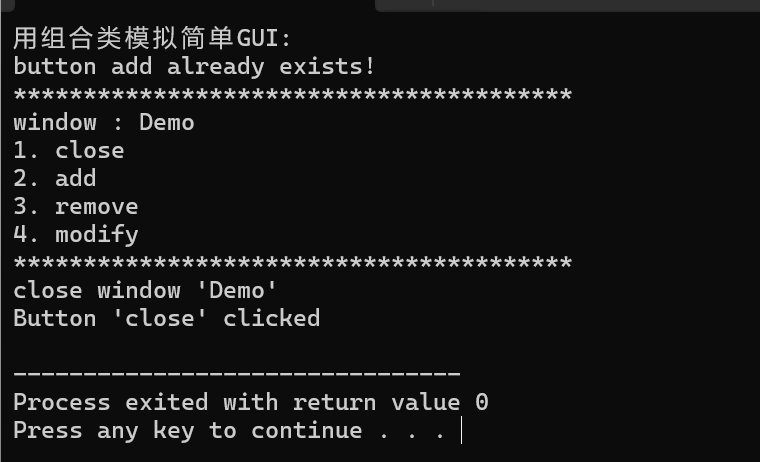
问题1:这个范例中,Window和Button是组合关系吗?
答:是组合关系。
问题2: bool has_button(const std::string &label) const; 被设计为私有。 思考并回答:
(1)若将其改为公有接口,有何优点或风险?
答:若将其改为共有接口,外部代码可以直接调用has_button;风险:破坏封装性。
(2)设计类时,如何判断一个成员函数应为 public 还是 private?(可从“用户是否需要”、“是否仅为内部实现细节”、“是否易破坏对象状态”等角度分析。)
答:public:函数是类对外提供的核心功能,且直接调用不会破坏对象的合法状态。
private:函数是类对内部辅助逻辑,或直接调用可能破坏对象状态。
问题3:Button的接口const std::string& get_label() const;返回const std::string&。对比以下两种接口设计在性能和安全性方面的差异并精炼陈述。
接口1:const std::string& get_label() const;
答:返回对label的引用,不会拷贝字符串,效率更高。但直接引用有安全风险。
接口2:const std::string get_label() const;
答:会创建新的字符串对象,效率较低。但直接拷贝不会对原字符串进行改变,安全性更高。
问题4:把代码中所有 xx.push_back(Button(xxx))改成 xx.emplace_back(xxx),观察程序是否正常运行;查阅资料,回答两种写法的差别。
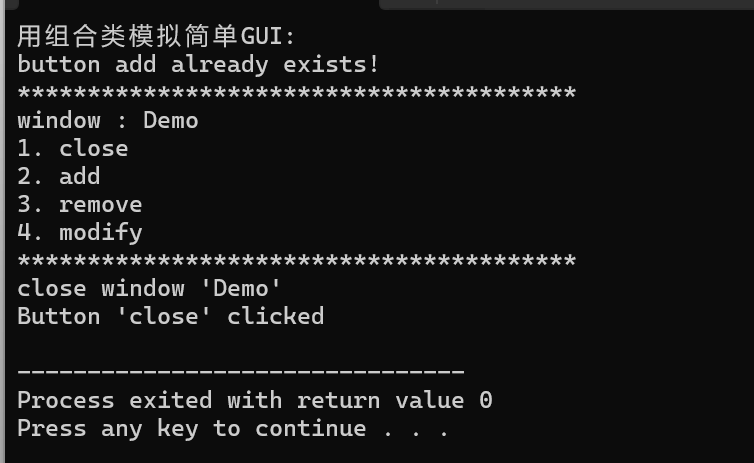
答:代码正常运行。前者先创建一个临时的 Button 对象(调用 Button 的构造函数),再将这个临时对象拷贝/移动到 vector 中,安全性更高。而后者不创建临时对象,效率更高。
任务二:
源代码:

1 #include <iostream> 2 #include <vector> 3 4 void test1(); 5 void test2(); 6 void output1(const std::vector<int> &v); 7 void output2(const std::vector<int> &v); 8 void output3(const std::vector<std::vector<int>>& v); 9 10 int main() { 11 std::cout << "深复制验证1:标准库vector<int>\n"; 12 test1(); 13 14 std::cout << "\n深复制验证2:标准库vector<int>嵌套使用\n"; 15 test2(); 16 } 17 18 void test1() { 19 std::vector<int> v1(5, 42); 20 const std::vector<int> v2(v1); 21 22 std::cout << "**********拷贝构造后**********\n"; 23 std::cout << "v1: "; output1(v1); 24 std::cout << "v2: "; output1(v2); 25 26 v1.at(0) = -1; 27 28 std::cout << "**********修改v1[0]后*********\n"; 29 std::cout << "v1: "; output1(v1); 30 std::cout << "v2: "; output1(v2); 31 } 32 33 void test2() { 34 std::vector<std::vector<int>> v1{{1, 2, 3}, {4, 5, 6, 7}}; 35 const std::vector<std::vector<int>> v2(v1); 36 37 std::cout << "**********拷贝构造后**********\n"; 38 std::cout << "v1: "; output3(v1); 39 std::cout << "v2: "; output3(v2); 40 41 v1.at(0).push_back(-1); 42 43 std::cout << "**********修改v1[0]后*********\n"; 44 std::cout << "v1: \n"; output3(v1); 45 std::cout << "v2: \n"; output3(v2); 46 } 47 48 // 使用xx.at()+循环输出vector<int>数据项 49 void output1(const std::vector<int> &v) { 50 if(v.size() == 0) { 51 std::cout << '\n'; 52 return; 53 } 54 55 std::cout << v.at(0); 56 for(auto i = 1; i < v.size(); ++i) 57 std::cout << ", " << v.at(i); 58 std::cout << '\n'; 59 } 60 61 // 使用迭代器+循环输出vector<int>数据项 62 void output2(const std::vector<int> &v) { 63 if(v.size() == 0) { 64 std::cout << '\n'; 65 return; 66 } 67 68 auto it = v.begin(); 69 std::cout << *it; 70 71 for(it = v.begin()+1; it != v.end(); ++it) 72 std::cout << ", " << *it; 73 std::cout << '\n'; 74 } 75 76 // 使用auto for分行输出vector<vector<int>>数据项 77 void output3(const std::vector<std::vector<int>>& v) { 78 if(v.size() == 0) { 79 std::cout << '\n'; 80 return; 81 } 82 83 for(auto &i: v) 84 output2(i); 85 }
运行结果截图:
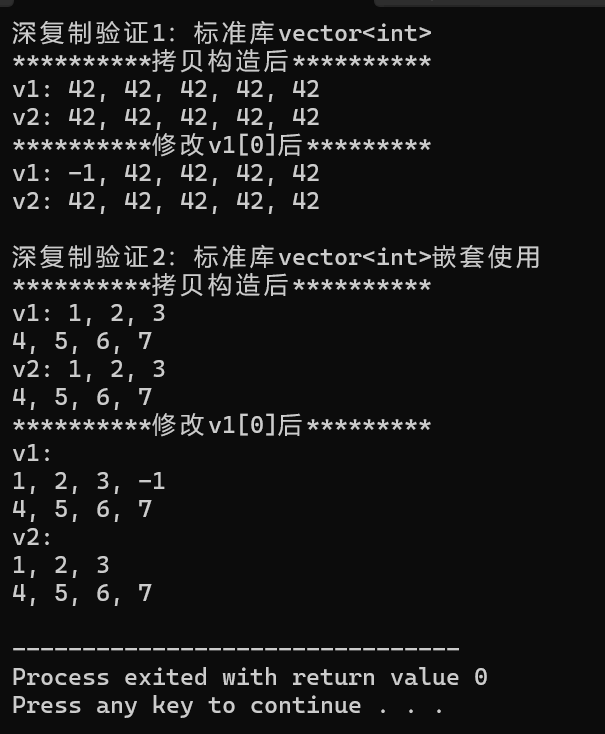
问题1:测试模块1中这两行代码分别完成了什么构造? v1、v2 各包含多少个值为 42 的数据项?
std::vector<int> v1(5, 42);
const std::vector<int> v2(v1);
答:创建一个包含5个元素的数组v1,每个元素赋初值为42,第二行拷贝v1到v2。
都包含5个值为42的数据项。
问题2:测试模块2中这两行代码执行后, v1.size()、v2.size()、v1[0].size()分别是多少?
std::vector<std::vector<int>> v1{{1, 2, 3}, {4, 5, 6, 7}};
const std::vector<std::vector<int>> v2(v1);
答:2,2,3。
问题3:测试模块1中,把v1.at(0) = -1;写成v1[0] = -1;能否实现同等效果?两种用法有何区别?
答:能实现等同效果。但前者会做越界检查,后者不会。
问题4:测试模块2中执行v1.at(0).push_back(-1);后
(1) 用以下两行代码,能否输出-1?为什么?
答:能输出。 r = v1.at(0) 是拷贝赋值, r.size()-1 是 r 的最后一个元素的索引, r.at(r.size()-1) 就是-1,因此能输出。
(2)r定义成用const &类型接收返回值,在内存使用上有何优势?有何限制?
答:避免拷贝,节省内存。但不能通过该引用修改原对象。
问题5:观察程序运行结果,反向分析、推断:
(1) 标准库模板类vector的复制构造函数实现的是深复制还是浅复制?
答:深复制。
(2) vector<T>::at() 接口思考: 当 v是vector<int> 时,v.at(0)返回值类型是什么?
答:int &。
当v是const vector<int>时,v.at(0)返回值类型又是什么?
答:const int &。
据此推断 at()是否必须提供带 const 修饰的重载版本?
答:必须。否则const vector 无法调用at()。
任务三:
源代码:

1 #include "vectorInt.hpp" 2 #include <iostream> 3 4 void test1(); 5 void test2(); 6 void output1(const vectorInt &vi); 7 void output2(const vectorInt &vi); 8 9 int main() { 10 std::cout << "测试1: \n"; 11 test1(); 12 13 std::cout << "\n测试2: \n"; 14 test2(); 15 } 16 17 void test1() { 18 int n; 19 std::cout << "Enter n: "; 20 std::cin >> n; 21 22 vectorInt x1(n); 23 for(auto i = 0; i < n; ++i) 24 x1.at(i) = (i+1)*10; 25 std::cout << "x1: "; output1(x1); 26 27 vectorInt x2(n, 42); 28 vectorInt x3(x2); 29 x2.at(0) = -1; 30 std::cout << "x2: "; output1(x2); 31 std::cout << "x3: "; output1(x3); 32 } 33 34 void test2() { 35 const vectorInt x(5, 42); 36 vectorInt y; 37 38 y.assign(x); 39 40 std::cout << "x: "; output2(x); 41 std::cout << "y: "; output2(y); 42 } 43 44 // 使用xx.at()+循环输出vectorInt对象数据项 45 void output1(const vectorInt &vi) { 46 if(vi.size() == 0) { 47 std::cout << '\n'; 48 return; 49 } 50 51 std::cout << vi.at(0); 52 for(auto i = 1; i < vi.size(); ++i) 53 std::cout << ", " << vi.at(i); 54 std::cout << '\n'; 55 } 56 57 // 使用迭代器+循环输出vectorInt对象数据项 58 void output2(const vectorInt &vi) { 59 if(vi.size() == 0) { 60 std::cout << '\n'; 61 return; 62 } 63 64 auto it = vi.begin(); 65 std::cout << *it; 66 67 for(it = vi.begin()+1; it != vi.end(); ++it) 68 std::cout << ", " << *it; 69 std::cout << '\n'; 70 }

1 #pragma once 2 3 #include <iostream> 4 5 // 动态int数组对象类 6 class vectorInt{ 7 public: 8 vectorInt(); 9 vectorInt(int n_); 10 vectorInt(int n_, int value); 11 vectorInt(const vectorInt &vi); 12 ~vectorInt(); 13 14 int size() const; 15 int& at(int index); 16 const int& at(int index) const; 17 vectorInt& assign(const vectorInt &vi); 18 19 int* begin(); 20 int* end(); 21 const int* begin() const; 22 const int* end() const; 23 24 private: 25 int n; // 当前数据项个数 26 int *ptr; // 数据区 27 }; 28 29 vectorInt::vectorInt():n{0}, ptr{nullptr} { 30 } 31 32 vectorInt::vectorInt(int n_): n{n_}, ptr{new int[n]} { 33 } 34 35 vectorInt::vectorInt(int n_, int value): n{n_}, ptr{new int[n_]} { 36 for(auto i = 0; i < n; ++i) 37 ptr[i] = value; 38 } 39 40 vectorInt::vectorInt(const vectorInt &vi): n{vi.n}, ptr{new int[n]} { 41 for(auto i = 0; i < n; ++i) 42 ptr[i] = vi.ptr[i]; 43 } 44 45 vectorInt::~vectorInt() { 46 delete [] ptr; 47 } 48 49 int vectorInt::size() const { 50 return n; 51 } 52 53 const int& vectorInt::at(int index) const { 54 if(index < 0 || index >= n) { 55 std::cerr << "IndexError: index out of range\n"; 56 // std::exit(1); 57 } 58 59 return ptr[index]; 60 } 61 62 int& vectorInt::at(int index) { 63 if(index < 0 || index >= n) { 64 std::cerr << "IndexError: index out of range\n"; 65 //std::exit(1); 66 } 67 68 return ptr[index]; 69 } 70 71 vectorInt& vectorInt::assign(const vectorInt &vi) { 72 if(this == &vi) 73 return *this; 74 75 int *ptr_tmp; 76 ptr_tmp = new int[vi.n]; 77 for(int i = 0; i < vi.n; ++i) 78 ptr_tmp[i] = vi.ptr[i]; 79 80 delete[] ptr; 81 n = vi.n; 82 ptr = ptr_tmp; 83 return *this; 84 } 85 86 int* vectorInt::begin() { 87 return ptr; 88 } 89 90 int* vectorInt::end() { 91 return ptr+n; 92 } 93 94 const int* vectorInt::begin() const { 95 return ptr; 96 } 97 98 const int* vectorInt::end() const { 99 return ptr+n; 100 }
运行结果截图:
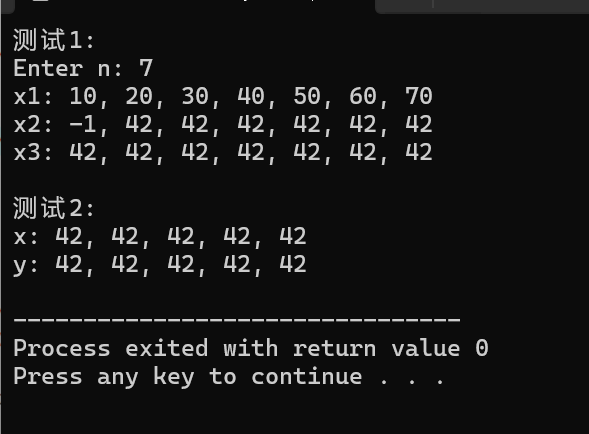
问题1:当前验证性代码中,vectorInt接口assign实现是安全版本。如果把assign实现改成版本2,逐条指出版本 2存在的安全隐患和缺陷。(提示:对比两个版本,找出差异化代码,加以分析)

答:版本2先释放内存,再创建新内存,若内存不足,数据可能丢失。
问题2:当前验证性代码中,重载接口at内部代码完全相同。若把非 const 版本改成如下实现,可消除重复并遵循“最小化接口”原则(未来如需更新接口,只更新const接口,另一个会同步)。

查阅资料,回答:
(1)static_cast<const vectorInt*>(this)的作用是什么?转换前后this的类型分别是什么?转换目的?
答:将当前非const对象的指针转换为const对象的指针。转换前:非const对象指针;转换后:const对象指针;转换目的:将当前非const对象的指针转换为const对象的指针。
(2)const_cast<int&>的作用是什么?转换前后的返回类型分别是什么?转换目的?
答:转换前:const int &,转换后:int &.转换目的:去除const属性,将返回值类型转换为int &.
问题3:vectorInt类封装了begin()和end()的const/非const接口。
(1)以下代码片段,分析编译器如何选择重载版本,并总结这两种重载分别适配什么使用场景。

答:v1非const对象;v2const对象。const用于const对象;非const用于非const对象。
(2)拓展思考(选答*):标准库迭代器本质上是指针的封装。vectorInt直接返回原始指针作为迭代器,这
种设计让你对迭代器有什么新的理解?
问题4:以下两个构造函数及assign接口实现,都包含内存块的赋值和复制操作。使用算法库<algorithm>改
成如下写法是否可以?回答这3行更新代码的功能。
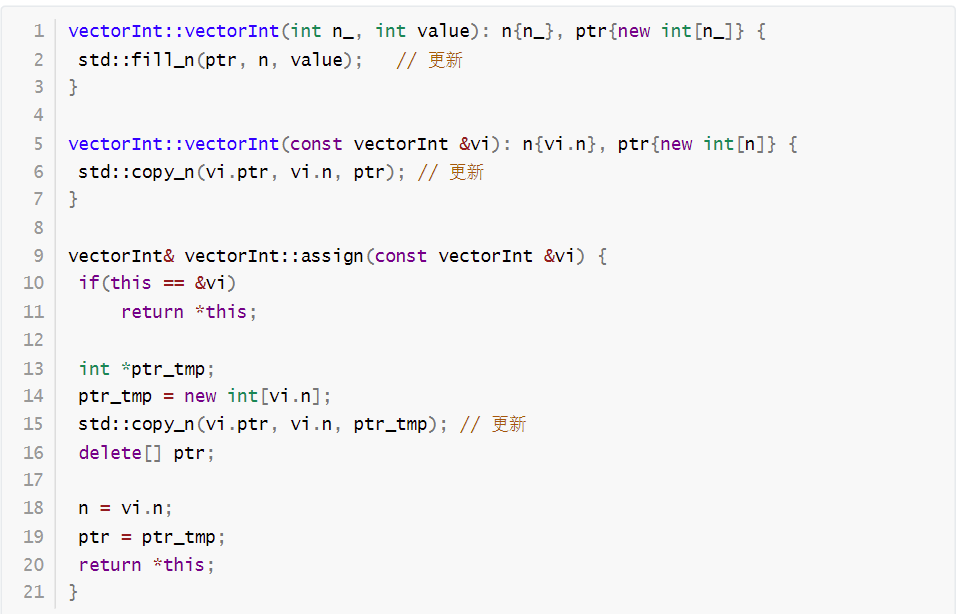
答:第二行:创建一个包含n个元素的VectorInt对象,且每个元素赋初值value。
第六行:拷贝一个新的VectorInt对象,深复制。
第十五行:赋值函数,深复制。
任务四:
源代码:

1 #include <iostream> 2 #include <cstdlib> 3 #include "matrix.hpp" 4 5 void test1(); 6 void test2(); 7 void output(const Matrix &m, int row_index); 8 9 int main() { 10 std::cout << "测试1: \n"; 11 test1(); 12 13 std::cout << "\n测试2: \n"; 14 test2(); 15 16 return 0; 17 } 18 19 void test1() { 20 double x[1000] = {1, 2, 3, 4, 5, 6, 7, 8, 9, 10}; 21 22 int n, m; 23 std::cout << "Enter n and m: "; 24 std::cin >> n >> m; 25 26 Matrix m1(n, m); // 创建矩阵对象m1, 大小n×m 27 m1.set(x, n*m); // 用一维数组x的值按行为矩阵m1赋值 28 29 Matrix m2(m, n); // 创建矩阵对象m2, 大小m×n 30 m2.set(x, m*n); // 用一维数组x的值按行为矩阵m1赋值 31 32 Matrix m3(n); // 创建一个n×n方阵对象 33 m3.set(x, n*n); // 用一维数组x的值按行为矩阵m3赋值 34 35 std::cout << "矩阵对象m1: \n"; 36 m1.print(); 37 38 std::cout << "矩阵对象m2: \n"; 39 m2.print(); 40 41 std::cout << "矩阵对象m3: \n"; 42 m3.print(); 43 } 44 45 void test2() { 46 Matrix m1(2, 3, -1); 47 const Matrix m2(m1); 48 49 std::cout << "矩阵对象m1: \n"; 50 m1.print(); 51 52 std::cout << "矩阵对象m2: \n"; 53 m2.print(); 54 55 m1.clear(); 56 m1.at(0, 0) = 1; 57 58 std::cout << "m1更新后: \n"; 59 60 std::cout << "矩阵对象m1第0行"; 61 output(m1, 0); 62 63 std::cout << "矩阵对象m2第0行 "; 64 output(m2, 0); 65 } 66 67 // 输出矩阵对象row_index行所有元素 68 void output(const Matrix &m, int row_index) { 69 if(row_index < 0 || row_index >= m.rows()) { 70 std::cerr << "IndexError: row index out of range\n"; 71 exit(1); 72 } 73 74 std::cout << m.at(row_index, 0); 75 for(int j = 1; j < m.cols(); ++j) 76 std::cout << ", " << m.at(row_index, j); 77 std::cout << '\n'; 78 }

1 #pragma once 2 3 #include <iostream> 4 #include <algorithm> 5 #include <cstdlib> 6 7 // 类Matrix声明 8 class Matrix { 9 public: 10 Matrix(int rows_, int cols_, double value = 0); // 构造rows_*cols_矩阵对象, 初值value 11 Matrix(int rows_, double value = 0); // 构造rows_*rows_方阵对象, 初值value 12 Matrix(const Matrix &x); // 深复制 13 ~Matrix(); 14 15 void set(const double *pvalue, int size); // 按行复制pvalue指向的数据,要求size=rows*cols,否则报错退出 16 void clear(); // 矩阵对象数据项置0 17 18 const double& at(int i, int j) const; // 返回矩阵对象索引(i,j)对应的数据项const引用(越界则报错后退出) 19 double& at(int i, int j); // 返回矩阵对象索引(i,j)对应的数据项引用(越界则报错后退出) 20 21 int rows() const; // 返回矩阵对象行数 22 int cols() const; // 返回矩阵对象列数 23 24 void print() const; // 按行打印数据 25 26 private: 27 int n_rows; // 矩阵对象内元素行数 28 int n_cols; // 矩阵对象内元素列数 29 double *ptr; // 数据区 30 };

1 #include "matrix.hpp" 2 #include <cstring> 3 #include <iostream> 4 5 // 普通矩阵构造(行×列,初始值) 6 Matrix::Matrix(int rows_, int cols_, double value) 7 : n_rows(rows_), n_cols(cols_) { 8 if (rows_ <= 0 || cols_ <= 0) { 9 std::cerr << "SizeError: rows/cols must be positive\n"; 10 std::exit(1); 11 } 12 ptr = new double[rows_ * cols_]; 13 for (int i = 0; i < rows_ * cols_; ++i) { 14 ptr[i] = value; 15 } 16 } 17 18 // 方阵构造(行=列,初始值) 19 Matrix::Matrix(int rows_, double value) 20 : Matrix(rows_, rows_, value) {} // 复用普通构造 21 22 // 深拷贝构造 23 Matrix::Matrix(const Matrix &x) 24 : n_rows(x.n_rows), n_cols(x.n_cols) { 25 ptr = new double[n_rows * n_cols]; 26 std::memcpy(ptr, x.ptr, sizeof(double) * n_rows * n_cols); 27 } 28 29 // 析构函数 30 Matrix::~Matrix() { 31 delete[] ptr; 32 } 33 34 // 设置数据(按行复制,检查size) 35 void Matrix::set(const double *pvalue, int size) { 36 if (size != n_rows * n_cols) { 37 std::cerr << "SizeError: size mismatch\n"; 38 std::exit(1); 39 } 40 std::memcpy(ptr, pvalue, sizeof(double) * size); 41 } 42 43 // 清空所有元素为0 44 void Matrix::clear() { 45 std::memset(ptr, 0, sizeof(double) * n_rows * n_cols); 46 } 47 48 // const版本元素访问(越界检查) 49 const double& Matrix::at(int i, int j) const { 50 if (i < 0 || i >= n_rows || j < 0 || j >= n_cols) { 51 std::cerr << "IndexError: (" << i << "," << j << ") out of range\n"; 52 std::exit(1); 53 } 54 return ptr[i * n_cols + j]; 55 } 56 57 // 非const版本元素访问(复用const版本) 58 double& Matrix::at(int i, int j) { 59 return const_cast<double&>( 60 static_cast<const Matrix*>(this)->at(i, j) 61 ); 62 } 63 64 // 获取行数 65 int Matrix::rows() const { 66 return n_rows; 67 } 68 69 // 获取列数 70 int Matrix::cols() const { 71 return n_cols; 72 } 73 74 // 按行打印矩阵 75 void Matrix::print() const { 76 for (int i = 0; i < n_rows; ++i) { 77 std::cout << at(i, 0); 78 for (int j = 1; j < n_cols; ++j) { 79 std::cout << ", " << at(i, j); 80 } 81 std::cout << "\n"; 82 } 83 }
运行结果截图:
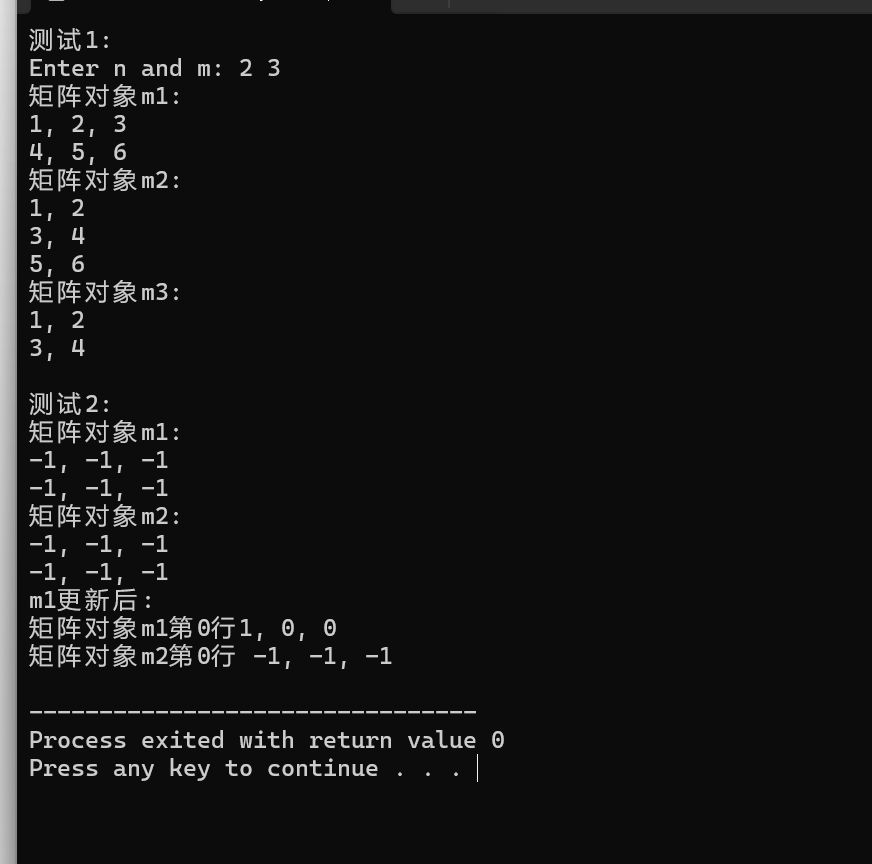
任务五:
源代码:

1 #include "contactBook.hpp" 2 3 void test() { 4 ContactBook contactbook; 5 6 std::cout << "1. add contacts\n"; 7 contactbook.add("Bob", "18199357253"); 8 contactbook.add("Alice", "17300886371"); 9 contactbook.add("Linda", "18184538072"); 10 contactbook.add("Alice", "17300886371"); 11 12 std::cout << "\n2. display contacts\n"; 13 std::cout << "There are " << contactbook.size() << " contacts.\n"; 14 contactbook.display(); 15 16 std::cout << "\n3. find contacts\n"; 17 contactbook.find("Bob"); 18 contactbook.find("David"); 19 20 std::cout << "\n4. remove contact\n"; 21 contactbook.remove("Bob"); 22 contactbook.remove("David"); 23 } 24 25 int main() { 26 test(); 27 }

1 # pragma once 2 3 #include <iostream> 4 #include <string> 5 #include <vector> 6 #include <algorithm> 7 #include "contact.hpp" 8 9 // 通讯录类 10 class ContactBook { 11 public: 12 void add(const std::string &name, const std::string &phone); // 添加联系人 13 void remove(const std::string &name); // 移除联系人 14 void find(const std::string &name) const; // 查找联系人 15 void display() const; // 显示所有联系人 16 size_t size() const; 17 18 private: 19 int index(const std::string &name) const; // 返回联系人在contacts内索引,如不存在,返回-1 20 void sort(); // 按姓名字典序升序排序通讯录 21 22 private: 23 std::vector<Contact> contacts; 24 }; 25 26 void ContactBook::add(const std::string &name, const std::string &phone) { 27 if(index(name) == -1) { 28 contacts.push_back(Contact(name, phone)); 29 std::cout << name << " add successfully.\n"; 30 sort(); 31 return; 32 } 33 34 std::cout << name << " already exists. fail to add!\n"; 35 } 36 37 void ContactBook::remove(const std::string &name) { 38 int i = index(name); 39 40 if(i == -1) { 41 std::cout << name << " not found, fail to remove!\n"; 42 return; 43 } 44 45 contacts.erase(contacts.begin()+i); 46 std::cout << name << " remove successfully.\n"; 47 } 48 49 void ContactBook::find(const std::string &name) const { 50 int i = index(name); 51 52 if(i == -1) { 53 std::cout << name << " not found!\n"; 54 return; 55 } 56 57 contacts[i].display(); 58 std::cout << '\n'; 59 } 60 61 void ContactBook::display() const { 62 for(auto &c: contacts) { 63 c.display(); 64 std::cout << '\n'; 65 } 66 } 67 68 size_t ContactBook::size() const { 69 return contacts.size(); 70 } 71 72 // 待补足1:int index(const std::string &name) const;实现 73 // 返回联系人在contacts内索引; 如不存在,返回-1 74 75 // 任务1:实现index函数(查找联系人索引,不区分大小写) 76 int ContactBook::index(const std::string &name) const { 77 for (size_t i = 0; i < contacts.size(); ++i) { 78 // 转换为小写后比较 79 std::string contactName = contacts[i].get_name(); 80 std::string targetName = name; 81 std::transform(contactName.begin(), contactName.end(), contactName.begin(), ::tolower); 82 std::transform(targetName.begin(), targetName.end(), targetName.begin(), ::tolower); 83 if (contactName == targetName) { 84 return i; 85 } 86 } 87 return -1; 88 } 89 90 91 // 待补足2:void ContactBook::sort();实现 92 // 按姓名字典序升序排序通讯录 93 94 // 任务2:实现sort函数(按姓名字典序升序排列) 95 void ContactBook::sort() { 96 std::sort(contacts.begin(), contacts.end(), [](const Contact &a, const Contact &b) { 97 return a.get_name() < b.get_name(); 98 }); 99 }

1 #pragma once 2 3 #include <iostream> 4 #include <string> 5 6 // 联系人类 7 class Contact { 8 public: 9 Contact(const std::string &name_, const std::string &phone_); 10 11 const std::string &get_name() const; 12 const std::string &get_phone() const; 13 void display() const; 14 15 private: 16 std::string name; //必填项 17 std::string phone; //必填项 18 }; 19 20 Contact::Contact(const std::string &name_, const std::string &phone_):name{name_}, phone{phone_} { 21 } 22 23 const std::string& Contact::get_name() const { 24 return name; 25 } 26 27 const std::string& Contact::get_phone() const { 28 return phone; 29 } 30 31 void Contact::display() const { 32 std::cout << name << ", " << phone; 33 }
运行结果截图:
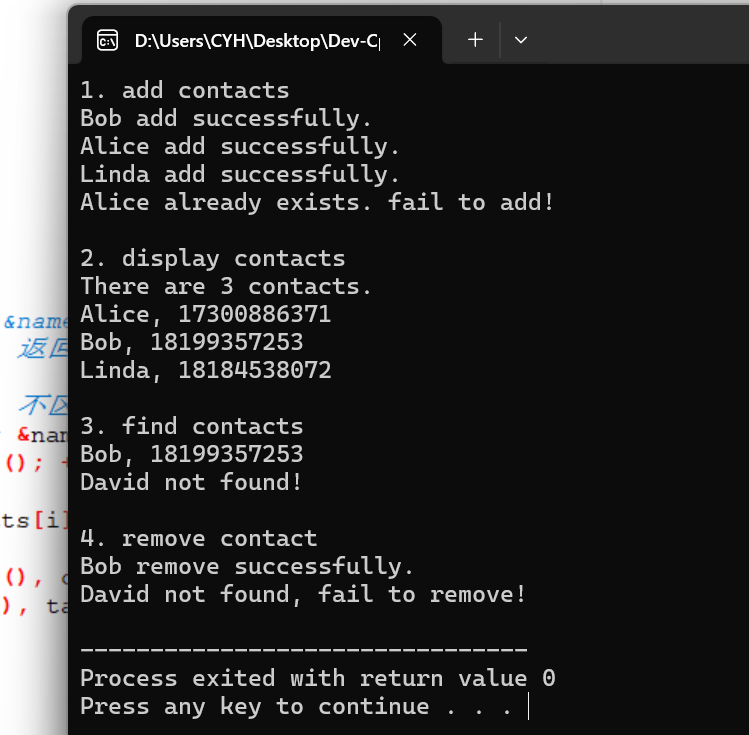
总结与思考:
1. 实验1
理解“组合关系”:容器类( Window )通过成员变量直接持有组件类( Button )对象;
掌握类的封装设计:通过 public/private 控制接口权限,调用与安全性思考。
2. 实验2
深复制特性: vector 拷贝构造/赋值会复制元素内容(非指针),保证对象独立性;
接口与安全: at() 做越界检查; const 对象调用 const 版本接口,非 const 对象调用非 const 版本。
3. 实验3
通过“动态数组+指针”实现自定义 vectorInt ,掌握 new/delete 的配对使用,避免内存泄漏;
深复制实现:拷贝构造/赋值函数需重新分配内存并复制数据,与浅复制区分。
4. 实验4
越界安全:通过 at() 对行列索引做检查;
深复制与析构:复杂对象需自定义拷贝构造、赋值、析构函数,实现资源的安全管理。
5. 实验5
容器与算法结合:利用 std::vector 存储对象,结合 std::sort 等算法实现高效的数据排序;
实用功能封装:通过私有工具函数( index )封装核心逻辑,对外提供简洁的业务接口(增删查);
不区分大小写匹配:掌握字符串处理技巧( std::transform ),实现更灵活的业务逻辑。






 浙公网安备 33010602011771号
浙公网安备 33010602011771号